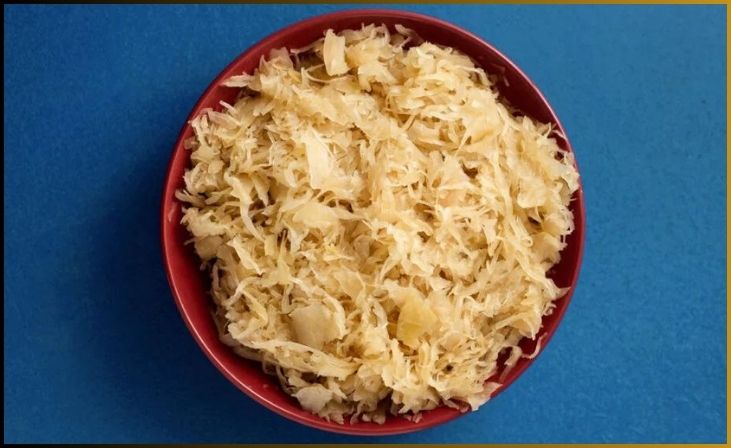Foreign to some, a taste of home and childhood to another, the popular ferment called sauerkraut, not to be confused with the misspelled sourcrout, is a great place to start if you’re new to fermenting. It is also the place where you can experiment with flavors and textures creating the most unique blends and the best crowd pleasers. It’s the gateway ferment that exposes one to a new level of health and well-being.
Table of Contents
ToggleWhat is sauerkraut?

Sauerkraut (again, not sourcrout) is basically cabbage that is cut up into fine slices and has been mixed with salt and allowed to ferment for a period of time by lactic acid bacteria. The lactic acid bacteria that is naturally found in the cabbage feeds on the sugar in the cabbage making it softer and more sour in taste. This fermentation process increases the nutrient levels of the cabbage and makes it more shelf stable to a certain degree all while giving it the most delicious and addicting flavor. I am salivating just thinking about fermenting sauerkraut.
Why should you make your own sauerkraut?
Well, let me tell you the top three reasons why I make sauerkraut!
Probiotics are Expensive… less diverse and less effective than store-bought. I have 7 children and a husband. To have my entire family on probiotics would cost me a fortune! Not to mention, the store-bought probiotics have only 10-20 different types of bacteria in them whereas naturally fermented
Sauerkraut has hundreds if not thousands! Naturally, fermented foods are already hardwired to transport delicious bacteria directly into your digestive system.
Taste is the Deal Breaker! Being able to control the level of sourness, the salt preference, the herbs, and other vegetables to accompany the cabbage greatly enhances your pleasure in consuming sauerkraut. Believe me!
Cost-Effective. A whole cabbage and a few tablespoons of salt costs what? A dollar or two!? Why wouldn’t you spend that dollar toward your health and your palate?!
Quick Link: How to Make Sauerkraut in a Jar
Don't just scroll, subscribe!
BuzzTrail's unique web-stories are the cure for boredom you've been waiting for.
How Do I Start?
My personal preference for fermented foods includes sauerkraut. It has a mild taste that complements a wide variety of dishes. The lack of heat makes it a hit with my children, unlike some other ferments. It’s a terrific and simple method to supplement your diet with beneficial probiotics.
Equipment Needed to Make Sauerkraut
You don’t require any specialized equipment for making sauerkraut; the process is wonderfully uncomplicated. All you need are:
- A large glass or ceramic jar.
- Some form of a heavy, flat-bottomed tamper for crushing the cabbage.
- A flat object to use as a weight, preferably close in size to the jar’s diameter.
- Fresh cabbage.
- Salt.
That’s the beauty of sauerkraut-making – it’s a centuries-old tradition that can be accomplished with the most basic supplies. Chances are, you already have these items on hand, and even if not, you can easily find improvisations in your kitchen to get started on your sauerkraut journey.
Sauerkraut Recipe Instructions
Making sauerkraut is a simple process, and while there are variations, the basic steps remain consistent: chop the cabbage, add salt, and keep it submerged in liquid for fermentation. You can also experiment with various flavors, like adding juniper berries or caraway seeds for a German twist.
Here’s a summary of the key steps:
- Prepare the Cabbage: Start by removing any damaged outer leaves, cutting the cabbage in half, and removing the core. Slice the cabbage thinly, ideally by hand, and toss it with salt. Allow it to sit for about 20 minutes until it begins to wilt and releases juices.
- Pound the Cabbage: Use a tamper or pounder to crush the cabbage until it’s wilted and has released a good amount of liquid. This step may take several minutes.
- Pack the Cabbage: Transfer the cabbage and its juices to a glass or ceramic jar or crock, packing it down with the tamper. Fill the jar about two-thirds full, as the cabbage will expand as it ferments and could overflow if too full.
- Ensure Submersion: Continue mashing the cabbage to release more juice, ensuring that it’s completely submerged under the brine. If necessary, make a supplemental brine with salt and water to cover the cabbage fully.
- Fermentation: It’s essential to keep the cabbage submerged under the brine throughout fermentation to prevent mold. You can use a weight that fits the inside of your container to achieve this.
- Taste and Store: After about four days of fermenting, start tasting the sauerkraut daily until it reaches your preferred texture and level of tanginess. Once satisfied, seal the jar tightly and store the sauerkraut in the fridge or a cool cellar between 38-50 degrees Fahrenheit.
Sauerkraut can be enjoyed raw to benefit from the probiotics or used in various recipes. It’s a versatile and healthy addition to your culinary repertoire.
Final Thoughts
Sauerkraut, with its distinct tang and probiotic richness, is a culinary gem that transcends cultural boundaries. Making your own sauerkraut is a rewarding journey, offering not only a flavorful addition to your meals but also a boost to your digestive health. As you venture into the world of sauerkraut, remember that simplicity is key – a few basic ingredients and the natural fermentation process are all you need to create this beloved dish.
Experiment with flavors, explore their health benefits and enjoy the timeless tradition of sauerkraut making. It’s an ancient skill that’s making a comeback, and it’s time for you to join the ranks of sauerkraut enthusiasts.
FAQs (Frequently Asked Questions):
1. What are the health benefits of sauerkraut?
1. What are the health benefits of sauerkraut?
Sauerkraut is a potent source of probiotics, aiding digestion and supporting a healthy gut. It’s rich in vitamins like C, K1, and B6 and offers potential benefits for the immune system and bone health.
2. Can I make sauerkraut without salt?
2. Can I make sauerkraut without salt?
While it’s possible to make sauerkraut without salt, it’s not recommended. Salt is essential for fermentation, preventing harmful bacteria, enhancing flavor, and extending the shelf life of sauerkraut.
3. How long does sauerkraut last, and can it be frozen?
3. How long does sauerkraut last, and can it be frozen?
Properly stored sauerkraut can last for many months, especially in a cool environment like the fridge. Freezing sauerkraut is possible, but it will kill the probiotics. If you want to preserve the probiotics, enjoy it raw.
4. Are there flavor variations for sauerkraut?
4. Are there flavor variations for sauerkraut?
Absolutely! Sauerkraut is versatile, and you can experiment with flavors. In Germany, ingredients like juniper berries or caraway seeds are common additions. Feel free to explore and create your own unique sauerkraut recipes.

